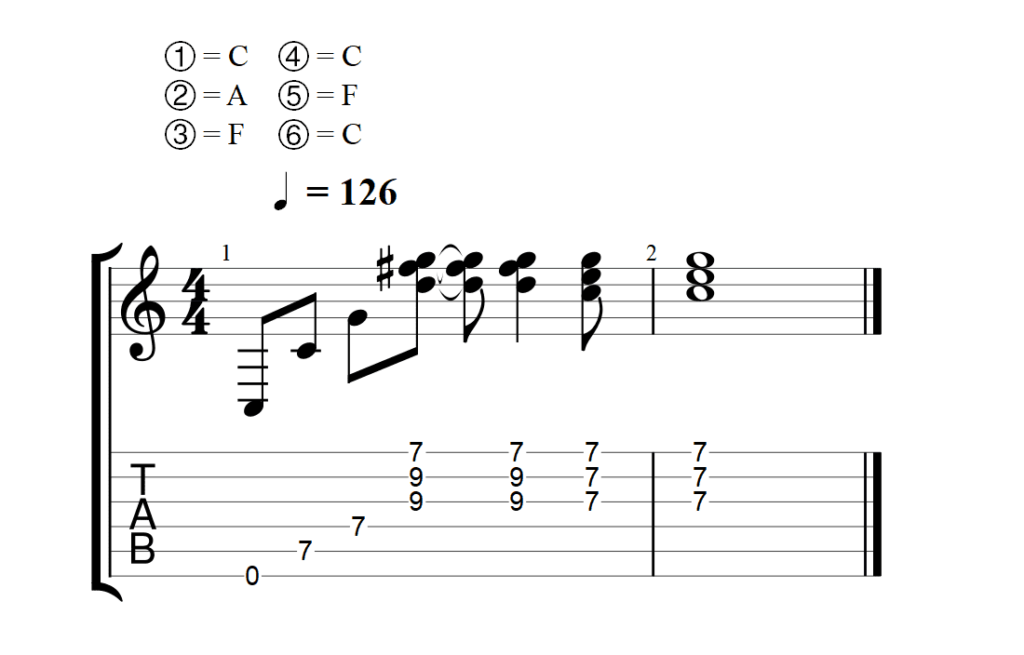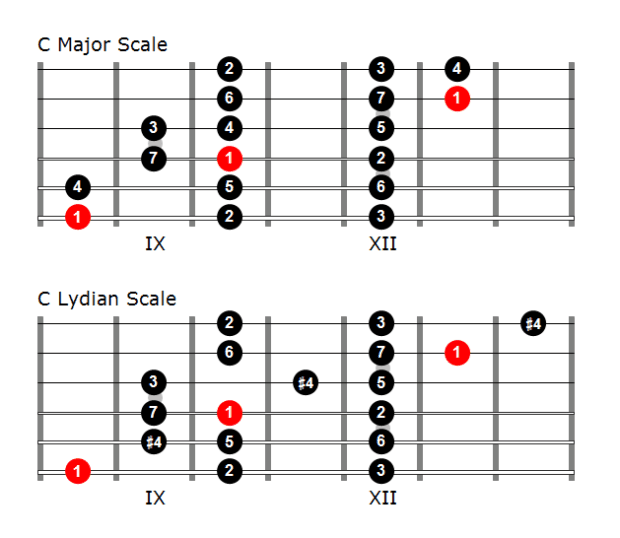Video length: 5 minutes 12 seconds
Artist website: satriani.com
Musicians
Joe Satriani – lead guitar
Galen Henson – rhythm guitar
Allen Whitman – electric bass
Mike Keneally – keyboards
Jeff Campitelli – drums
What makes this video great and what can you learn from it?
- “Flying In A Blue Dream” is a prime example of the Lydian sound and feel and therefore a great reference track to internalize Lydian.
- All the usual Satriani trademarks like legato, pick tapping, slides and whammy dips are included.
- It demonstrates how you can still add bluesy licks even when playing a tune with such a floating feel (3:03-3:08).
- This performance is an impressive live rendition of the original studio recording.
- I’ve always thought that the song title perfectly matches the mood and feel of the track.
What can you learn from this article?
- the difference between a regular major scale and the Lydian mode
- how to play the Lydian mode on guitar
- a break-down of other articulation techniques Joe has used in this song
Key Moments In “Flying In A Blue Dream”
| technique/concept | video timestamp |
|---|---|
| Lydian cluster voicing | 0:20-1:05 |
| Use of feedback | 00:06-00:50, 4:58-5:04 |
| Slides | 0:51-0:58 |
| Legato | 1:43-1:58 |
| Whammy dips | 1:26-1:33, 2:04-2:07, 3:50-3:57, 4:05-4:19 |
| Chromatic approaches into outlined triad | 2:13-2:19 |
| Tremolo picking | 2:38 |
| Bluesy lick | 3:04-3:08 |
| Pick tapping | 4:32-4:34 |
“Flying In A Blue Dream” is all about a recurring dream Joe Satriani initially experienced as a child. A dream of flying where young Joe would start out in his room and over time would end up in a translucent and crystallized blue dream world. When he was working on his “Flying In A Blue Dream” album in 1989, a combination of such a dream and a Yamaha steel string guitar in open F (low to high: C-F-C-F-A-C) tuning, helped him create this masterpiece.
A Modern Take on the Blues Using Lydian
Yes, there are modifications like a bVI chord (Ab in this case), but in essence the song follows a Blues progression. Instead of the commonly used dominant 7th chords, Satriani however opts for a Lydian feel and heavily features the #11. For example, the I chord is played as a C5(9 #11) with the notes C (root), C (octave) and G (fifth) arpeggiated and followed up with a cluster of D, F# and G (9th, #11, 5th) which then resolves to a basic, straight-forward major triad. You can hear this rhythmic figure played by the rhythm guitarist Galen Henson starting at 0:20 until the harmony changes at 1:05.
Lydian Cluster Voicing

Lydian cluster voicing: 0:20-1:05 – back to overview
For the other chords in the progression, the bVI chord (Ab), the V chord (G) and the IV chord (F), the initial arpeggiated part of the rhythm figure gets changed from “root – octave – fifth” to a quintal harmony approach consisting of “root – fifth – ninth” instead. The cluster of 9th, #11th and 5th with the following resolution to the basic major triad stays constant all the time.
Throughout the melody the #11 gets featured by Joe as an emphasized note. This mysterious sound is the perfect choice to represent Joe’s dream in a musical way.
The #11 is the characteristic note of the Lydian mode. In case you don’t know, a Lydian scale is quite similar to the conventional major scale. The only difference is that the 4th note is raised by a semi-tone. This raised 4th (which equals the #11) gives the scale its characteristic dreamy, mystical mood.
Lydian Mode on the Guitar
Have a look at the following diagrams to see the difference between a 3 note-per-string major scale and the Lydian mode:

So, learning Lydian actually is not as difficult as the scale’s name might suggest. As long as you know your major scales. Simply change the 4th in every major scale pattern you know to arrive at a Lydian pattern. However, to truly master the Lydian scale and use it effectively, you will have to get to the point where you don’t have to take a detour to the major scale first.
People should practice their scales by singing them, just one octave and whatever key position your throat can handle.
Joe Satriani
In conjunction with singing the scale away from the instrument as well as playing Lydian on the instrument, one of the best methods of learning a mode is to have a song you know and like as a reference point. Try to get to a point where you can imagine the sound and feel and recall the association to the mode. This will make it a lot easier for you to recognize the mode when it’s used in other songs. Listening to “Flying In A Blue Dream” is a great 1st step to get the sound and feel of Lydian into your mind and inner ear.
Other Techniques/Concepts to Notice
Here are some more interesting techniques and playing concepts for you to notice and emulate.
Use of Feedback
For setting the mood and creating a kind of “otherworldly” effect Joe uses feedback. I’m not talking about the uncontrolled, high-pitched, squealing kind of feedback that just hurts whenever it occurs. This is rather about that endlessly sustaining ethereal kind of sound. It’s tough to consistently achieve feedback at the correct note, but Satriani manages to “play” feedback as much as the regular notes.
For feedback to occur, the sound of the guitar coming out of the amp needs to have enough volume energy to make the strings vibrate. This creates a loop of sorts where the vibrating strings produce the sound that goes through the amp only to keep the strings vibrating which produces the sound that goes through the amp to keep the strings vibrating. You get the picture. Apart from the required high(er) volume other factors as room acoustics and the right physical placement of the instrument to the speakers play an important in creating the effect. A little luck also can be helpful.
Feedback during intro and outro: 00:06-00:50, 4:58-5:04 – back to overview
Slides
There are many reasons to use slides. You get the sound of the articulation itself which already adds a unique character and flavor. Additionally, sliding on a string keeps the timbre similar. You don’t change e.g. to a thicker string with a slightly different tonal character. The timbre stays consistent since you stay on the same string. This can add continuity and consistency to a phrase.
Slides used in opening phrase: 0:51-0:58 – back to overview
Legato
Joe is one of the masters of legato playing. Pay attention to how he achieves a fluid, almost liquid kind of mood by using legato in in combination with free timing, especially noticeable at 1:43 – 1:58.
Legato in combination with free timing: 1:43-1:58 – back to overview
Whammy Dips
You can use the whammy bar to change the pitch of the notes played. Joe tastefully uses this technique to make a somewhat static part of the melody more interesting and rhythmically active.
Whammy dips: 1:26-1:33, 2:04-2:07, 3:50-3:57, 4:05-4:19 – back to overview
Chromatic Approaches Into Outlined Triad
Beginning at 2:13 Joe outlines the notes of an Em triad. Over the C chord harmony the notes of Em function as 3rd, 5th and maj 7th. All those notes are good sounding points of resolutions and by chromatically approaching those notes from a half-step below Joe is able to add tension to make his solo more interesting while knowing that the tension resolves to a “safe” note when landing on the triad components.
Chromatic approaches into outlined triad: 2:13-2:19 – back to overview
Tremolo Picking
Just a short example, but considering the reputation Joe has as a left hand legato monster, I think it’s important to highlight the speed and fluidity he also demonstrates when using conventional alternate picking in tremolo style.
Tremolo picking: 2:38 – back to overview
Bluesy Lick
I’ve always loved that bluesy lick – it’s such a nice contrast to the modal stuff and it serves as a kind of grounding tool. Bringing us all back to earth after the flight and returning to the main melody.
Bluesy lick: 3:04-3:08 – back to overview
Pick Tapping
Instead of using the right hand fingers to tap notes Joe often uses the edge of his pick. In doing so he is able to achieve an even faster and more aggressive tapping sound and effect.
Pick tapping: 4:32-4:34 – back to overview
Conclusion
Joe Satriani has incredible technique. But he also plays very melodically and is a master of creating moods and atmospheres. In this song he uses the Lydian mode to great effect. If you haven’t learned/mastered Lydian yet, get started with it. It’s an extremely useful scale to know and belongs into every guitarist’s toolbox.
Sources
Gitarre & Bass 1990/01
Guitar World Magazine 1989/11
Guitar Techniques 2004/05
Get notified whenever I publish a new article!
Absolutely NO Spam – Unsubscribe Anytime.







